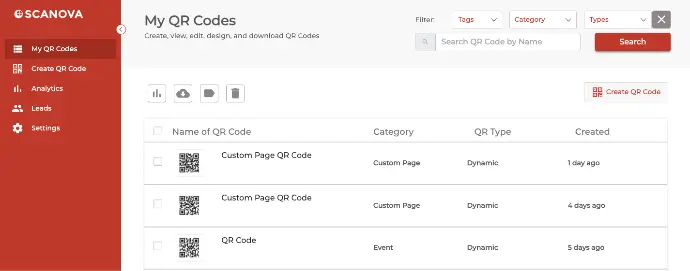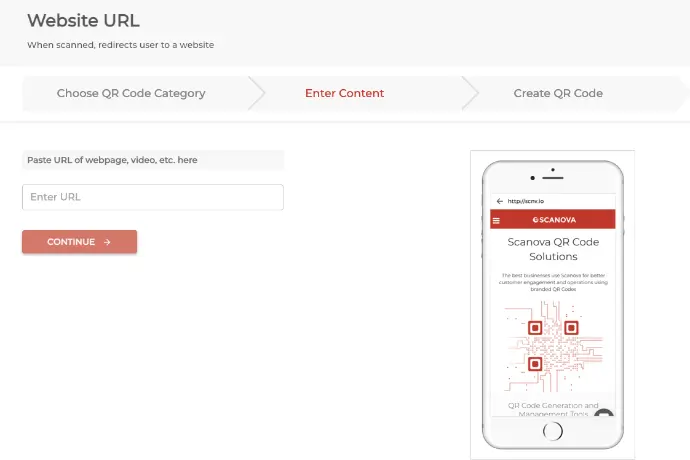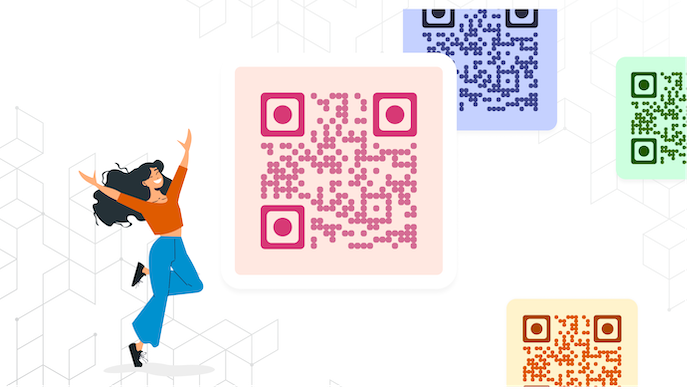If you’ve stumbled upon this article it means you’re looking for a QR Code for one of your use cases.
A Quick Response (QR) Code is a matrix that stores information just like a traditional barcode.
QR Codes come alive within a second of holding your camera in front of them. And they can hold a lot more information than the good old barcodes.
In fact, if we go with the numbers, it’s usage is increasing globally. And why not? The IT/Cloud infrastructure needed to take a scan is now readily available—a camera-enabled smartphone and internet connection.
That’s why many industries today use QR Codes for different use cases. For example:
- Making promotional creatives interactive
- Enabling smooth logistics
- Authentication services
You have a use case too. And you need to create a QR Code for the same. But before we get started on how to create one, let’s see what kind of content categories QR Codes offer:
Related : Best QR Code Generator
A. What can a QR Code Do?
1) Take end-users to your website
A Website URL QR Code is one of the most common types of QR Codes.
As the name suggests, it stores a web link. And when the end-users take a scan, it takes them to the required webpage without having to manually type the URL.
Wondering why this is helpful? Well, because when the user journey becomes easier, the campaign engagement rate improves. To make things even more promising, make sure your website has a good UI and easy navigation. Services such as VPS Windows hosting help you do it and you can check the design and UI with tools such as Computer Mockups.
2) Get people to visit your location
When was the last time you received an event invitation with the venue address printed on it? In such cases, you need to find the venue location by asking someone for directions or spotting it on the maps application.
This is where a Google Maps QR Code comes in handy.
As one scans it, it sends them to the required location on their phone’s maps application. They can then find their way to the venue in no time.
3) Help people contact you
Remember the last time you received a business card? We receive them all the time. But how often do we end up actually saving the contact details?
Well, not quite frequently, right? That’s why most business cards end up in the trash can and not in the recipient’s phone.
But a Vcard QR Code helps ensure that doesn’t happen to you.
It stores all your contact details. And we’re not just talking about your name, email, company, and phone.
Generate a QR Code For Your Unique Case
START TODAY!
It could also be a description, profile picture, social media handles, and a lot more!
When the end-users take a scan, they see a landing page with all these details and a ‘Save as Contact’ button. No need for them to manually type anything.
That means the chances of recipients actually saving your contact increases.
4) Share wedding or event details smartly
The physical invitation cards are certainly more personal than the digital ones. But they have a couple of constraints.
For example, they don’t have enough printing space to accommodate a couple of pictures. Neither can they help you readily share other multimedia (such as video and files).
In such cases, adding an Event QR Code to the cards can help you out. It helps you share a lot of details such as:
A. Event details and description
B. Exact maps location of the venue
C. Images, videos, and documents
D. RSVP button to help guests mark if they’ll attend the event or not
E. Social sharing buttons
F. Option to add the event to the calendar
That means your invitations become smarter and more useful than ever before.
5) Get a Coupon
It feels so good when we receive a special offer or discount coupon. But carrying it all the time can be quite a task.
And imagine shopping to redeem the offer but finding that you forgot to carry it during billing.
To do away with such problems, a Coupon QR Code comes to your rescue.
When scanned, it redirects you to a mobile coupon landing page with all the offer details. And the end-users also see the Redeem button.
They can then click on it to avail of the offer.
6) Send and receive payments
This use case needs no introduction. You might have already scanned one to make a payment. Or you might have shared a QR Code to receive the payments.
Due to ease of use and hassle-free operations, QR Code-based payments have become very popular today. They are easy, secure, and reliable.
7) Share important text
It’s often not possible to share as many details as you want via print. The most common example can be found in product packaging.
In such cases, a Text QR Code helps you out. It can save all the information that you couldn’t add to print. That’s why many authors also add QR Codes in their books to share the details that couldn’t be added as text.
It could be helpful to share:
A. Product information
B. Product code
C. Coupon code
D. Special messages
While these are just some categories, there’s a lot more that you can do with QR Codes. Let’s now see what steps you need to follow for getting started with creating a QR Code.
B. Getting a QR Code: Step-by-step guide
Using Scanova for a demo, here’s a detailed guide to creating a QR Code for any use case:
1) Visit Scanova & sign up for a 14-day free trial. Don’t worry, you’ll not have to enter your credit card details

2) On the page that loads, select the content category of your choice. For a demo, let’s select the Website URL
3) Enter the web link that you’d like to save in the QR Code

4) Click on Continue
5) Enter an appropriate name and proceed ahead
6) On the next page, you’ll see a preview of the QR Code with the Edit Design button. Clicking on it will show you two design options:
Custom Logo Design which helps you add colors, custom patterns, and logo to the center.
Custom Background Design which adds an image to the QR Code background.
7) After you’re done designing (or not designing) the QR Code, you can update the changes to download the file
8) Next, just specify an image format and size. Then, export your QR Code
That’s it. That’s all you need to know about the steps to get started on getting a QR Code. In case you’re interested, here’s a detailed guide on how you can add design to it.
Generate a QR Code For Your Unique Case
START TODAY!
